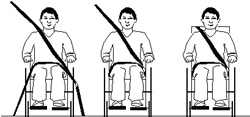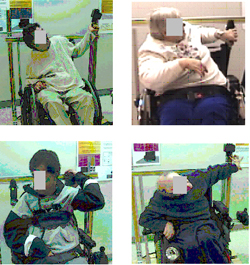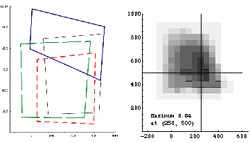Safety Belt Usability and Reach Capability of Wheelchair Users
ABSTRACT
This paper describes usability issues related to wheelchair occupant restraint systems for individuals seated in wheelchairs who have upper-extremity impairments relating to strength, range of motion, and dexterity. In a laboratory study, 10 people who sit in wheelchairs in motor vehicles evaluated safety belt usability in three occupant restraint scenarios. A coordinate measurement instrument was used to assess the participants' reach capabilities for purposes of establishing guidelines for safety belt positioning. The findings of the study address methods to improve independence, seat belt usage, belt comfort and safety among the wheelchair-seated population traveling in motor vehicles.
KEYWORDS:
Wheelchair, safety belt, usability, restraint, transportation
PROBLEM STATEMENT
People seated in wheelchairs in motor vehicles are protected in crashes and vehicle maneuvers by a two-part safety system. The wheelchair is secured to the vehicle using a four point tie-down or docking system and the wheelchair occupant is restrained to the wheelchair or to the vehicle by a safety belt consisting of a pelvic and shoulder belt [1] .
Currently installed v ehicle-mounted safety belts are often difficult to use independently and properly because of wide variance in occupant and wheelchair size, and interference of the wheelchair structure with the belt system [2, 3] . Poor belt fit may result in pelvic belts crossing the soft tissue of the abdomen, creating the potential for abdominal injury in a crash. Shoulder belts crossing the occupant too close to the neck or too far from the neck may cause poor upper body restraint resulting in occupant impact with the vehicle interior [4] .
An impediment to designing safe belt systems that maximize the independence of wheelchair-seated individuals is a lack of data on functional abilities related to seat belt use and belt donning by the wheelchair using population. Of particular interest are usability issues related to belt buckles and latch plates and data on the zones within which wheelchair occupants can reach and grasp stowed safety belts. Findings of this study can guide manufacturers towards the development of safety belts for wheelchair users that provide appropriate restraint but are easy to use. Improved safety belt design can increase perceived user comfort of restraint systems and the frequency of occupant restraint usage and thus the safety of wheelchair users traveling in motor vehicles.
METHOD
 |
|---|
Ten study participants were recruited in the Pittsburgh area by word-of-mouth, email, and phone (IRB # 021034). Most individuals had impaired range of motion or strength in one or both upper extremities. Eight of the participants used power or power-assisted wheelchairs, one used a manual chair, and one used a scooter.
A safety belt system simulator with reconfigurable anchor points was developed to present various seat belt scenarios to people seated in their own wheelchairs. The seat belt simulator fits various individuals seated in a variety of wheelchairs. Three safety belt scenarios were evaluated for usability (Figure 1):
- Pelvic and torso belt with all anchorages on the vehicle or on the tiedown system;
- A wheelchair-integrated pelvic belt with a vehicle-mounted torso belt that connects to the latch plate of the lap belt; and
- A fully integrated system with both lap and shoulder anchorages on the wheelchair.
 |
|---|
Video and interview data were collected from four men and six women using the above restraint scenarios.
To evaluate reach among the wheelchair seated individuals, a laterally adjustable, vertically oriented plane was placed adjacent to the left and right of the safety belt simulator. M easurements were made on the measurement surface directly adjacent to the wheelchair and also 200 mm outboard from that position. Participants demonstrated their reach capability by drawing with a marker on the vertical plane positioned at the side of the wheelchair at the highest, lowest, most-rearward, and most-forward positions that he or she could reach (Figure 2). Data were collected for both hands and for reaches to the ipsilateral and contralateral sides. A digital coordinate measuring instrument, the FARO Arm (FARO Technologies, Lake Mary , FL ) was used to record the three-dimensional reach locations of each individual.
 |
|---|
RESULTS
Usability Issues: All study participants had one or more problems when using the various safety belt scenarios presented to them and they used adaptive tactics for utilizing the various belts scenarios:
- Unable to reach for the latch plate of the torso belt due to its placement too far behind and/or next to the shoulder. Subjects would (1) turn their upper body and use an alternative arm, (2) bend forward to allow more space for stretched arm or (3) shift their balance and lean sideways to enable reaching for the latch plate (Figure 3).
- Unable to grasp hold of the latch plate due to slippery plate material and limited hand grasp function. To grasp hold of the latch plate, subjects would (1) use the latch plate hole to hook their finger in and (2) grasp the belt instead of the latch plate.
- Unable to don the torso belt over the torso due to strong retractor tension, limited pull strength and/or limited hand strength. Therefore subjects would (1) clamp the belt under one arm and re-grasp the latch plate with the opposite hand, (2) pull the belt and hold it in place with the teeth and re-grasp the latch plate with the opposite hand.
- Unable to connect the latchplate into the buckle due to the non-fixed buckle location positioned too far rearward, and the latch plate that was slippery and required alignment accuracy. Subjects would connect the latchplate into the buckle by (1) pulling the buckle forward, closer to the latchplate, (2) clamping the buckle between leg and hand and (3) use of both hands to connect the latchplate into the buckle.
- Unable to disconnect the latch plate from the buckle due to too much force needed to disengage. Subjects would use (1) two hands to depress the buckle or (2) knuckles or alternative fingers than index finger to depress and disconnect the buckle.
Reach Evaluation:
 |
|---|
Figure 4 (left) shows sample data from one participant overlaid in side view. This participant was able to complete reaches to both the zero- and 200-mm lateral positions (measured from the most outward side of the wheelchair) and with all four hand/reach-direction combinations (right hand to right and left side, left hand to left and right side). Figure 4 (right) shows a density plot for all participants in the 200 mm plane. Data from reaches to the same side as the hand (right hand reaching right, left hand reaching left) are combined, as are opposite-side reaches. The plot origin is the seat to back rest intersection point. Peak density reach location is indicated by the darkest zone.
CONCLUSION AND DISCUSSION
Based on the results the authors give the following recommendations for seat belt design for individuals with upper extremity limitations. (1) The stowed location of the latch plate should be located forward of the wheelchair occupant's shoulder. (2) The latch plate should allow users to ‘hook on' to the plate and don the belt without requiring a pinch or power grip. (3) Buckle design should allow for single-handed latch plate engagement and disengagement, and also allow flexibility to latch plate alignment during engagement. (5) The buckle should be visible to the user. The pilot data suggest that a point about 250 mm forward of the seat to back rest intersection and no higher than 750 mm above the seat to back rest intersection point would likely be optimal for wheelchair seated individuals with limited upper extremity function.
These recommendations represent substantial design challenges, because designing for usability may conflict with occupant restraint requirements unless innovative designs are developed. For example, the requirement that the buckle be visible to the user to facilitate latching the belt suggests a higher and more forward buckle on a rigid stalk. Yet, such a design might impair the dynamic performance of the lap belt by introducing slack into the system. Further research will be needed to develop restraint systems that combine improved ease of use with optimal crash protection.
REFERENCES
- ANSI/RESNA, ANSI/RESNA WC-19: Wheelchairs Used as Seats in Motor Vehicles . 2001, ANSI/RESNA.
- Van Roosmalen, L., G.E. Bertocci, D.A. Hobson, and P. Karg, Preliminary evaluation of wheelchair occupant restraint system usage in motor vehicles. Journal of Rehabilitation Research and Development, 2002. 39 (1).
- Sprigle, S., B. Morris, G. Nowacek, and P. Karg, Assessment of adaptive transportation technology: a survey of users and equipment vendors. Assistive Tech. 1994. 6 : p. 111-119.
- Bertocci, G.E., K. Digges, and D.A. Hobson, Shoulder belt anchor location influences on wheelchair occupant crash protection. Journal of Rehab Research and Development, 1996. 33 (3): p. 279-289.
ACKNOWLEDGEMENTS
This research was supported by the National Institute on Disability and Rehabilitation Research (Grant # 133E010302). The authors thank the Kinedyne Corporation for donating seat belt equipment. Opinions expressed in this paper are those of the authors and do not necessarily reflect those of the funding agency.
Linda van Roosmalen, PhD, IDSA.
University of Pittsburgh
5044 Forbes Tower
Pittsburgh PA
15260
Phone (412) 3836794
Email: Lvanroos@pitt.edu
